#Cathédrale Notre-Dame de Strasbourg
Text
The best timepiece in the world (IMO): Strasbourg Cathedral's Astronomical Clock

I could go on about this thing for ages. There's so much history, so many symbols to spot, and so much information on display... This is going to be a long one.
I guess I'll start with the artistic aspect on which I have the least to say because it's the least up my alley. There's loads of mythology and Christian symbolism going on on this 18-metre tall monument, and these are the main draw for the general public, because they move around.

Like cuckoo clocks in neighbouring Schwarzwald, this astronomical clock has automatons. Every quarter hour, the lower level of the photo above sees a change of "age": a child, a young man, an adult and an old man take turns to be in the presence of Death, whose bells toll on the hour. At high noon, the upper level also moves, with the 12 disciples passing before Christ, and the rooster at the very top crows.

Moving on to what really makes me tick: the amount of information on this clock is incredible. The time, obviously, but actually two times are on display on the clock at the bottom of the picture above: solar time and official time. Given Strasbourg's position in the time zone, there is a 30-minute discrepancy between the two. Then there's all the astronomical stuff, like the phase of the Moon (just visible at the top), the position of the planets relative to the Sun (middle of the picture), a celestial globe at the base (pictures below, on the right)...


The main feature behind the celestial globe is another clock displaying solar time, with the position of the Sun and Moon (with phases) relative to the Earth, sunrise and sunset times, surrounded by a yearly calendar dial. These have remarkable features, such as the Moon hand that extends and retracts, making eclipses noticeable, and the calendar has a small dial that automatically turns to place the date of Easter at the start of each year. This sounds easy, but look up the definition of Easter and note that this clock is mechanical, no electronic calculating power involved! Either side of the base, the "Ecclesiastic Computer" and the "Solar and Lunar Equations" modules work the gears behind these features.
The accuracy of this clock and its ambition for durability are truly remarkable. Relative to modern atomic time, it would only need adjusting by 1 second every 160 years, and it correctly manages leap years (which is not as simple as "every 4 years"). It just needs winding up once a week.

Finally, the history. The monumental clock was built in the 16th century, and used the calendar dial above, now an exhibit in Strasbourg's city history museum. It slowly degraded until the mid-19th century, when Jean-Baptiste Schwilgué restored the base and upgraded the mechanisms. The "dartboard" on the old dial contained information like the date of Easter, whether it is a leap year, which day of the week the 1st January is... - all of which had to be calculated by hand before the dial was installed! - and was replaced by the Ecclesiastic Computer, which freed up the centre space for the big 24-hour clock, complete with Solar and Lunar Equations.
As you may have gathered, I am a massive fan of this clock. Of course, nowadays, all the imagery and information would easily fit into a smart watch, but a smart watch isn't 18 metres tall and powered by gravity and gears!
#France#Alsace#Strasbourg#Cathédrale Notre-Dame de Strasbourg#horloge astronomique#astronomical clock#best timepiece in the world#fight me#or rather raise me a more impressive one if you think you've got one#only downside is that it's tricky to get good photos#it's rather dimly lit and using the flash is not a good idea#2019-09
16 notes
·
View notes
Text
Strasbourg | Betoverende historie en schoonheid
Vrijdag, 2 augustus 2019 | De komende dagen struinen wij door de binnenstad van Strasbourg/Straatsburg. Strasbourg is de laatste stad van onze Vijf steden reis door Frankrijk. Wandel mee door de betoverende binnenstad van Strasbourg, waar geschiedenis en schoonheid hand in hand gaan.
Op goed geluk dwalen we door de stad zodat we de unieke atmosfeer kunnen proeven, alvorens we ons onderdompelen…

View On WordPress
0 notes
Text

Cathédrale Notre-Dame-de-Strasbourg, France: Strasbourg Cathedral or the Cathedral of Our Lady of Strasbourg, also known as Strasbourg Minster, is a Catholic cathedral in Strasbourg, Alsace, France. Although considerable parts of it are still in Romanesque architecture, it is widely considered to be among the finest examples of Rayonnant Gothic architecture. Wikipedia
91 notes
·
View notes
Text
0 notes
Text
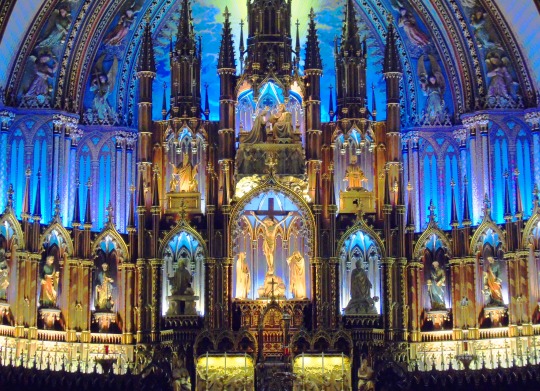

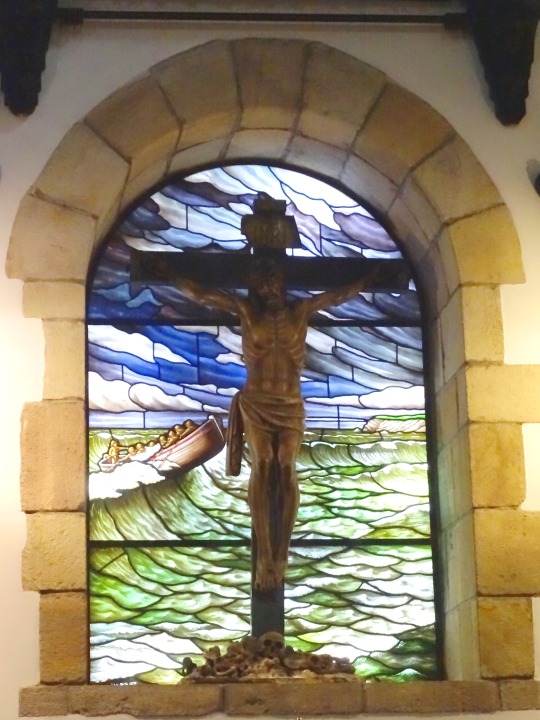
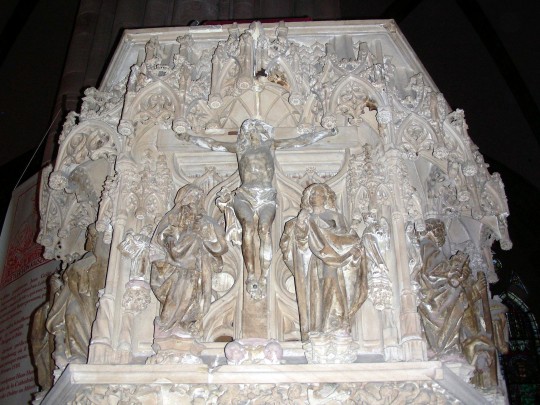


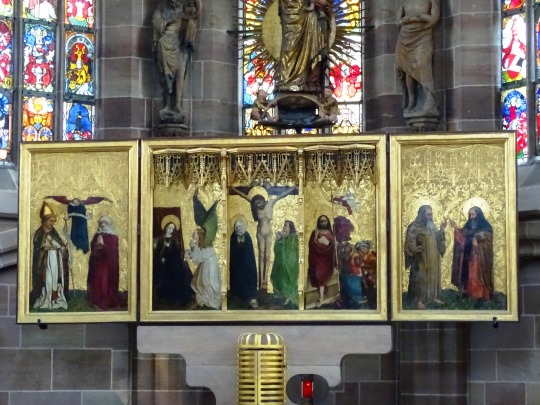

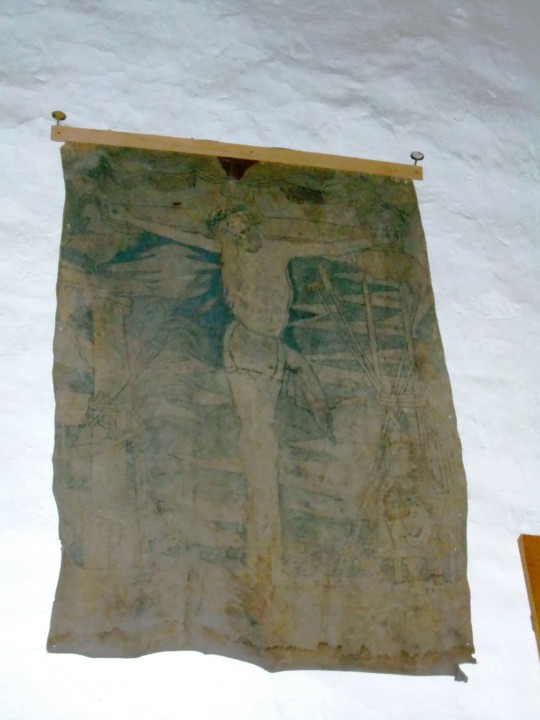
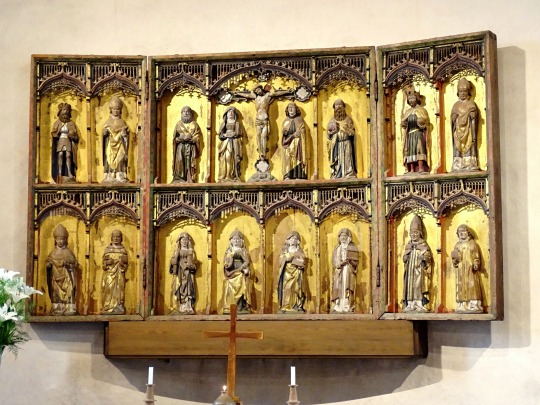

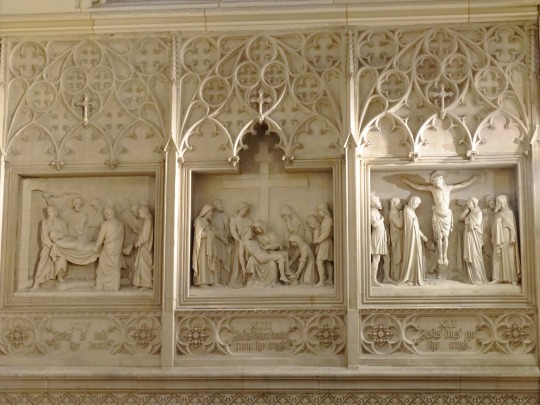

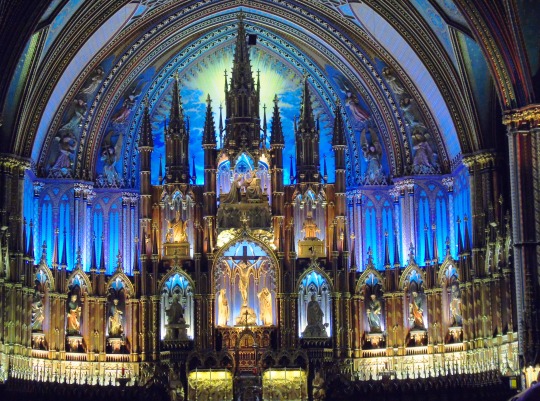
Good Friday
Observed in remembrance of the crucifixion of Jesus, this significant event is usually marked by church services and solemn reflections.
Let’s dive into the fascinating story of Good Friday, a day that’s all about remembering, reflecting, and a bit of solemnity.
It’s a day celebrated across the globe, honoring the sacrifice of Jesus Christ. It’s Good Friday, and it’s anything but your average Friday.
Good Friday falls on the Friday just before Easter Sunday. This day is special because it commemorates a key event in Christianity: the crucifixion of Jesus Christ. Think of it as a moment in history that’s both tragic and transformative. This makes it a pivotal day for many around the world.
So, why do people observe Good Friday? Well, it’s a day to ponder the sacrifices made by Jesus, who Christians believe died on the cross to offer humanity redemption and eternal life. It’s a mix of mourning the death of Jesus and looking forward to the hope his resurrection brings.
Christians spend the day in prayer, fasting, and attending church services, which often include re-enactments of Jesus’ final hours.
This observance isn’t just about looking back. It’s also about finding hope in what’s to come, symbolizing new beginnings and the powerful love that the narrative of Jesus’ crucifixion and resurrection brings to the forefront.
Good Friday is a day steeped in deep meaning, observed with both solemn rituals and hopeful reflections. It’s a moment when time seems to pause, inviting everyone to reflect on profound themes of life, death, and what comes after.
Whether you’re deeply religious or just curious about the traditions, there’s something about Good Friday that invites introspection and offers a glimpse into the heart of human longing for redemption and new beginnings.
History of Good Friday
Good Friday has a rich history that dates back centuries, evolving into a day that holds profound significance for Christians worldwide.
It commemorates the crucifixion of Jesus Christ, an event that is central to the Christian faith. According to scientists, it took place around 33 A.D. The day is observed on the Friday before Easter Sunday, marking the end of Holy Week.
The origins of Good Friday’s observance can be traced to early Christianity, with its significance growing over the centuries.
It embodies the ultimate sacrifice of Jesus, who died on the cross for humanity’s sins, paving the way for salvation and eternal life. This act of love and sacrifice is the cornerstone of Good Friday’s observance. This leads to its name, which reflects the good that came from Jesus’ sacrifice despite the sorrow of his death.
Traditions and rituals on Good Friday vary widely among different Christian denominations and cultures. However, common practices include fasting, prayer, and attending church services. These services often recount Jesus’ hours on the cross, from noon to 3 p.m.
Those hours reflect the hours of Jesus’ agony. In many places, the day is also marked by the veneration of the cross. It represents Jesus’ crucifixion and meditations on the “Stations of the Cross,” which depict the final hours of Jesus’ life.
The historical and spiritual depth of Good Friday underscores its importance in Christianity. It’s a day of reflection on Jesus’ sacrifice and the profound love that led to humans’ redemption.
How to Celebrate Good Friday
Good Friday offers a unique opportunity to pause, reflect, and engage in meaningful traditions that honor the crucifixion of Jesus Christ. Here are some creative and solemn ways to observe this day:
Embrace a Day of Fasting and Prayer: Dive into a spiritual journey by fasting and dedicating time to prayer.
This practice honors the sacrifices made on Good Friday and brings a deeper focus to your spiritual life. Consider abstaining from food and digital distractions to allow for quiet reflection and connection with the divine.
Silent Reflection: Carve out moments of silence throughout the day to meditate on the gravity of Good Friday. Whether through prayer, reading scripture, or simply sitting in quiet contemplation, this practice can help you internalize the day’s significance and find personal meaning in the observance.
Engage in Acts of Kindness and Charity: Reflect Jesus’ love and sacrifice by extending kindness and help to those in need. Volunteer, donate, or perform acts of kindness as a tangible way to honor the spirit of Good Friday. This could be as simple as helping a neighbor or more structured, like volunteering at a local charity.
Participate in a Good Friday Service: Attending a Good Friday service can be a powerful way to commemorate the day. Many churches offer services that recount the story of Jesus’ crucifixion through readings, hymns, and prayers.
Family Time and Storytelling: Spend quality time with family discussing the meaning of Good Friday. You could read Bible stories or watch films that depict the life and sacrifices of Jesus Christ. This not only educates younger family members about the day’s importance but also strengthens family bonds through shared faith.
Walking the Steps of Jesus: If possible, retracing the steps of Jesus to Calvary can be a moving way to connect with Him. While not accessible to everyone, even virtual walks or meditations on this journey can provide a profound sense of closeness.
Source
#Good Friday#Friday before Easter Sunday#GoodFriday#29 March 2024#USA#Karfreitag#St. Patrick's Cathedral#Manhattan#New York City#original photography#Notre-Dame-de-Bon-Secours Chapel#Montréal#Canada#Basilique Notre-Dame de Montréal#Santa Fe#Strasbourg Cathedral#La Cathédrale de Strasbourg#France#San Miguel Chapel#Cathedral of St John the Baptist#Charleston#travel#vacation#tourist attraction#cityscape#architecture#Sweden#Germany#GreatFriday#HolyFriday
1 note
·
View note
Text
Cathédrale Notre-Dame de Strasbourg derrière le Palais Rohan depuis le quai des bateliers près de la Passerelle de l'Abreuvoir
Notre-Dame de Strasbourg Cathedral behind the Palais Rohan from the boatmen's quay near the water trough footbridge

#flickr#photographers on tumblr#original photographers#artist on tumblr#outdoor#canon eos r#24-70mm f/4l is usm#strasbourg#alsace#cityscape
18 notes
·
View notes
Text


Cathédrale Notre-Dame de Strasbourg
8 notes
·
View notes
Text





Cathédrale Notre-Dame-de-Strasbourg (2) (3) (4) (5) by Anna Nielsson
Via Flickr:
www.annajanephoto.com
(1) La Petite France
(3) (4) (5) Ponts Couverts
#canals#waterways#traditional house#historic buildings#doors#decorative elements#rivers#bridges#towers#france#grand est
8 notes
·
View notes
Text
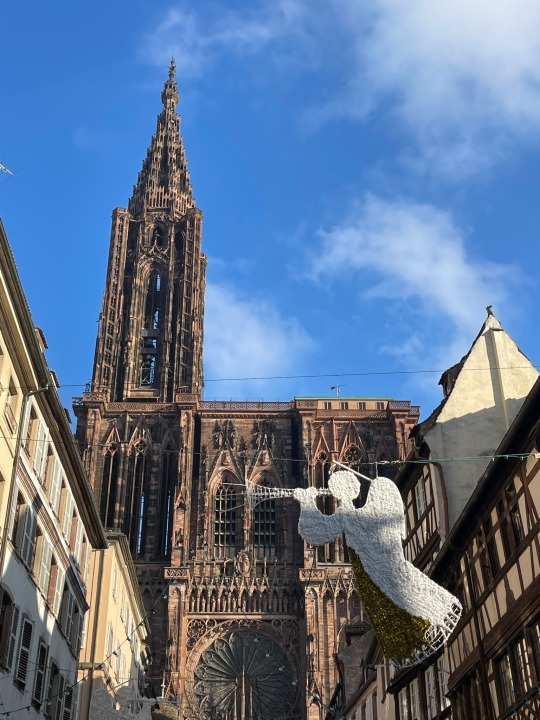
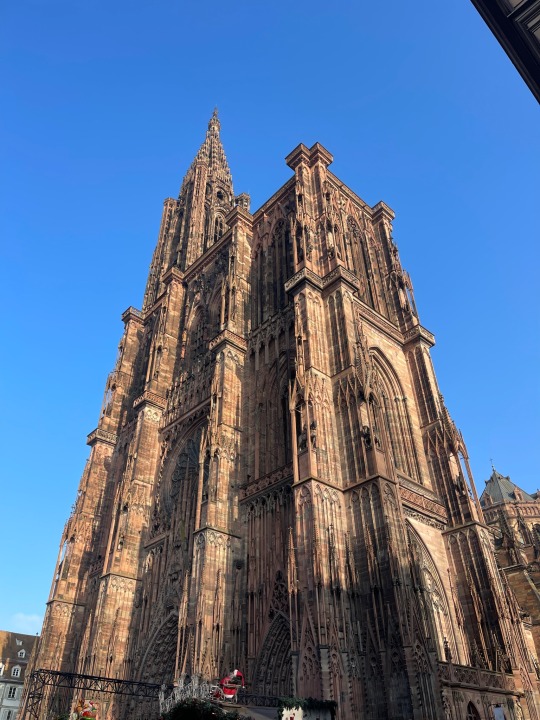
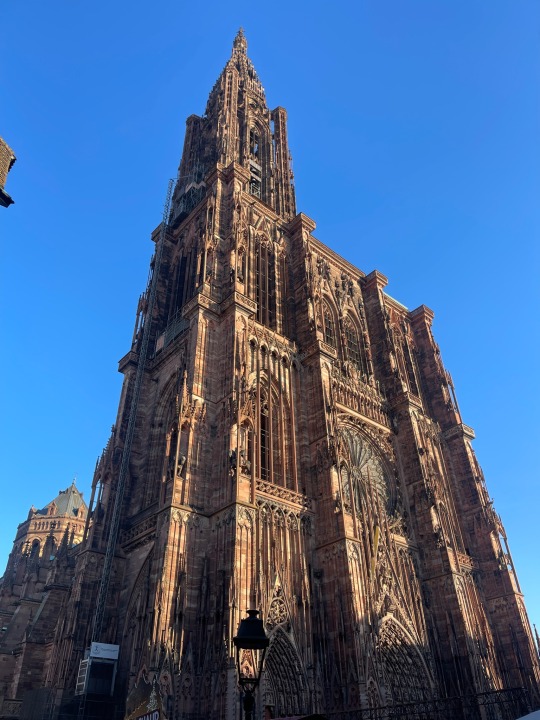

.
Cathédrale Notre-Dame de Strasbourg (The Cathedral of Our Lady of Strasbourg)
Standing in the centre of Place de la Cathédrale, at 142 metres (466 feet), Strasbourg Cathedral was the world's tallest building from 1647 to 1874 (227 years), when it was surpassed by St. Nikolai's Church, Hamburg. Today it is the sixth-tallest church in the world and the tallest extant structure built entirely in the Middle Ages.
The cathedral is visible far across the plains of Alsace and can be seen from as far off as the Vosges Mountains or the Black Forest on the other side of the Rhine. The reddish-brown sandstone from the Vosges mountains gives the cathedral its distinctive colour.
In 1988, the Strasbourg Cathedral was inscribed on the UNESCO World Heritage List along with the historic centre of the city (called the "Grande Île") because of its outstanding Gothic architecture
8 notes
·
View notes
Text
Cathédrale Notre-Dame de Strasbourg

2 notes
·
View notes
Text
Strasbourg and the Bombardment of Plaine des Bouchers, May 27, 1944.

Note: Bibliography references in bold and italics.
After the fall of France in World War II, northern France was occupied by the Third Reich, and southern regions were self-governed by the Vichy-France puppet regime. However, Strasbourg, with the eastern regions of Alsace and Moselle, were directly annexed and became part of wartime Germany.
This meant that citizens of Alsace, Moselle and cities like Strasbourg, were conscripted to serve with the armed forces of the Third Reich. Existing French factories were converted to arms production, universities changed their focus to weapons development. Some hospital facilities were used for horrific experiments on live persons, others were very secretive locations developing weapon-grade Uranium-235 for the Third Reich. 6 7
The Bombardment of Strasbourg 1943-44
With this, allied bombing raids targeted factories and rail lines in Strasbourg. In 1943-44, there were three very severe bombing raids by U.S. Air-force heavy bombers:
On September 6, 1943 the Strasbourg neighborhood of Neudorf was heavily bombed by 332 B-17 Flying Fortresses and 69 B-24 Liberator bombers from VIII Bomber Command who were trying to destroy a railway yard and rail line that connected to a strategically important bridge crossing the Rhine. In the process, the residential area of Route du Polygone was heavily damaged, including a neighboring orphanage. 183 civilians were killed. 1
On August 11, 1944 the historic centre of Strasbourg was heavily bombed by 65 B-24 Liberators. Damage was very severe, and evidence remains today. The medieval Cathédrale Notre Dame de Strasbourg was damaged, as was the Palais de Rohan. L’ Ancienne Douane de Strasbourg was almost completely destroyed, but has since been restored. The reason for this bombardment should be clear, but it is not. Historians suggest that the target was a meeting amongst important industrialists chaired by Martin Bormann. I remain skeptical. Possibly, it was, somehow, about securing weapon-grade Uranium-235 that might be available in Strasbourg. This would shorted the Pacific War for the Americans, and explain the puzzling secrecy. 1
The Bombardment of Plaine des Bouchers - May 27, 1944.
Earlier, on May 27, 1944, the aviation factories in the industrial area of Plaine des Bouchers were attacked by B-17’s from the 100th and 388th Bomber Group. This was part of a massive widespread bombing raid consisting of 1,126 heavy bombers and 710 fighter escorts. Of this strike force, 53 bombers targeted the airplane factories at Plaine des Bouchers. This important industrial area was seriously defended, and 7 B-17’s were lost in the raid.
As the name suggests, “Plaine des Bouchers”, centuries ago, was a location for grazing cattle, but was later developed into an industrial hub in the mid-20th century. Emile Mathis, a French automobile industrialist, built large industrial facilities here. At the outset of the War, he left for the United States.
When Strasbourg and Alsace were annexed to Germany by the Third Reich, they used these modern facilities for building airplanes: Junkers was here, as was Mercedes Benz, both using the modern factories built by Emile Mathis.
However, M. Mathis was now in the United States, and he understood these factories better than anyone. He explained, to the US Air Force, how to focus their bombing in this industrial zone. It worked: on May 27, 1944 the Junkers and Mercedes Benz factories were destroyed by the US 8th Air Force. Bravo M. Emile Mathis, this helped shorten the war. 1 4
Here is a description of the raid on Plaine des Bouchers by 388th Bomber Group: - Captain Raymond G. Pendergast Jr.:
“We left England at 1054 and arrived at the French coast 1114. We made landfall at exactly the same place we made it May 25 when flak knocked hell out of us. Our whole crew sweated out that flak corridor but not a fire was shot at us. A few bursts were sent up but about 5 minutes before we arrived, flak was encountered about 10 miles north of Troyes but was not effective.
On the way to the target, we got a swell view of the Alps and snow was quite noticeable. They really are beautiful and also the surrounding country. At the target, plenty of flak was shot up and rockets too. Most of it was aimed at groups ahead of us who bombed a bit further south. We had comparatively little flak sent up at us. From the target out no flak was encountered and fighter cover was excellent. Red and possibly green flak was seen at the target.” 5



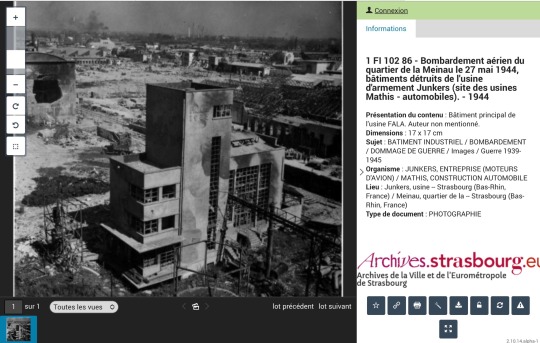

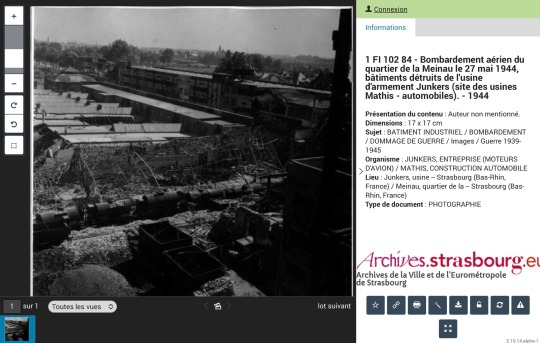
Bibliography:
1. Objectif Strasbourg, les bombardements Américains de 1943 et 1944, Richard Seiler, Éditions La Nuée Bleue, 2013
2. Archives de la Ville et de l’Eurométropole de Strasbourg, Archives.Strasbourg.eu.
3. 30 Photos de Strasbourg sous les bombardements (1943-1944), https://www.kuriocity.fr/30-photos-de-strasbourg-sous-les-bombardements-1943-1944/
4. Les arrêts de tram strasbourgeois : Émile Mathis, https://pokaa.fr/2019/03/19/les-arrets-de-tram-strasbourgeois-episode-1-emile-mathis/
5. 388th Bomber Group Database, “Captain Raymond G. Pendergast Jr.”, http://388bg.com
6. “German nuclear program during World War II”, https://en.m.wikipedia.org/wiki/German_nuclear_program_during_World_War_II
7. “Alsos Mission”, https://en.m.wikipedia.org/wiki/Alsos_Mission
8. Medical Research in Strasbourg after annexation to the Third Reich https://www.tumblr.com/johnlyngfr/700149416337784832/medical-research-in-strasbourg-after-annexation-to
9. History of Strasbourg,
https://en.m.wikipedia.org/wiki/History_of_Strasbourg#:~:text=In%20August%201944%2C%20several%20buildings,Armoured%20Division%20under%20General%20Leclerc.
3 notes
·
View notes
Text

La cathédrale Notre Dame de Strasbourg en Alsace 🥨
3 notes
·
View notes
Text
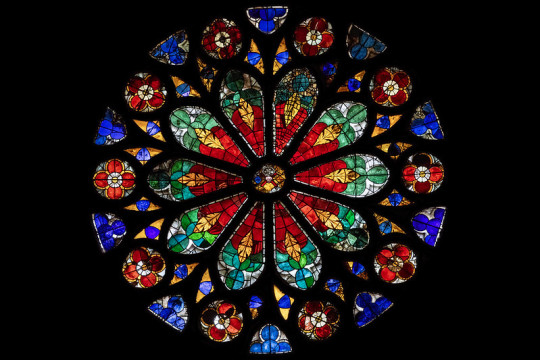
Cathédrale Notre-Dame de Strasbourg by Alexandre Prevot
4 notes
·
View notes
Text
Découvrez l'EuroVelo 6 : une incroyable aventure à vélo de l'Atlantique à la Mer Noire

L'EuroVelo 6 est un parcours cyclable qui traverse l'Europe, reliant l'Océan Atlantique à la Mer Noire. Suivant les côtes, fleuves et châteaux, cette route offre des paysages variés et exceptionnels à explorer en selle. Dans cet article, nous vous présentons un itinéraire détaillé pour découvrir cette voie unique sur deux roues.
Le parcours global de l'EuroVelo 6
Ce tracé emblématique s'étend sur plus de 4 000 km, traversant dix pays européens et empruntant principalement des voies vertes ou des pistes cyclables sécurisées. L'EuroVelo 6 suit les cours d’eau majeurs tels que le Rhin, le Danube et la Loire, offrant ainsi des panoramas époustouflants et des sites historiques à chaque étape du trajet.
Les différentes sections de l'EuroVelo 6
Afin de faciliter votre voyage, l'itinéraire complet se divise en plusieurs sections, que vous pouvez réaliser séparément ou dans leur ensemble :
- La section atlantique (France) : de Nantes à Bâle.
- La section rhénane (Allemagne, Suisse, France) : de Bâle à Passau.
- La section danubienne (Allemagne, Autriche, Slovaquie, Hongrie) : de Passau à Budapest.
- La section centre-européenne (Croatie, Serbie, Roumanie, Bulgarie) : de Budapest au delta du Danube.
- La section finale (Roumanie, Bulgarie, Turquie) : du delta du Danube à la Mer Noire.
Les étapes phares de l'Itinéraire vélo EuroVelo 6
Découvrez quelques-uns des temps forts de cet itinéraire qui marqueront votre périple :
Nantes
Située sur l'estuaire de la Loire, Nantes est une ville pleine de charme dotée d'un riche patrimoine historique et culturel. Avant de partir pour l'EuroVelo 6, prenez le temps de visiter le château des ducs de Bretagne, la cathédrale Saint-Pierre-et-Saint-Paul ou encore les célèbres Machines de l'île.
Le Val de Loire
Inscrit au patrimoine mondial de l'UNESCO, le Val de Loire vous émerveillera par ses paysages bucoliques et ses châteaux emblématiques comme ceux de Chambord, Chenonceau, Amboise ou Azay-le-Rideau. Ne manquez pas non plus les jardins de Villandry et les dégustations de vins locaux dans les caves troglodytiques.
Strasbourg
Capitale européenne et alsacienne, Strasbourg est une étape incontournable sur l'EuroVelo 6. Admirez la magnifique cathédrale Notre-Dame, flânez dans le quartier pittoresque de la Petite France et traversez le Rhin pour rejoindre l'Allemagne via le pont Pierre Pflimlin.
Le Danube
Le long du fleuve le plus long d'Europe, vous passerez par des sites spectaculaires comme les falaises calcaires de la Porte-de-Bavière, le Parc Naturel Donau-Auen en Autriche ou encore le Parc National Đerdap à la frontière serbo-roumaine. De nombreux villages typiques jalonnent également ce tronçon, permettant de découvrir les traditions locales.
Budapest
Surnommée la "Perle du Danube", Budapest offre un panorama unique depuis le pont Széchenyi Lánchíd avec ses collines de Buda et la plaine de Pest encadrant le fleuve. Profitez de cette étape pour visiter le château royal, les bains thermaux de Gellért ou le Parlement hongrois, puis dégustez un goulasch traditionnel dans les rues animées.
Le Delta du Danube
Cette zone protégée offre une biodiversité exceptionnelle et constitue un paradis pour les ornithologues avec plus de 300 espèces d'oiseaux nicheurs. Entre canaux labyrinthiques et marais sauvages, vous partirez à la découverte des traditions ancestrales de la pêche et de l'élevage qui marquent cette région unique.
La Mer Noire
Votre aventure sur l'EuroVelo 6 se termine sur les plages dorées de la Mer Noire, où vous pourrez célébrer votre réussite en savourant un poisson grillé accompagné d'un verre de vin local. Les stations balnéaires de Varna (Bulgarie) et Constanta (Roumanie) offrent une multitude d'animations estivales pour conclure en beauté ce périple inoubliable.
Préparer son voyage sur l’EuroVelo 6
Pour profiter pleinement de ce parcours d’exception, il convient de bien préparer son voyage :
- Voies cyclables : informez-vous sur les pistes accessibles et les conditions de circulation dans chaque pays traversé.
- Hébergements : réservez vos étapes à l’avance, en tenant compte de la saison et du dénivelé.
- Budget : prenez en compte l’ensemble des frais engagés, tels que les transports jusqu’à votre point de départ, la location ou l’achat de matériel, les repas et les visites touristiques.
- Gastronomie locale : découvrez lors de votre itinéraire, les spécialités culinaires de chaque région et goûtez aux produits locaux.
Avec ces quelques conseils en tête, vous voilà prêt à partir à la découverte de l'EuroVelo 6, des splendeurs naturelles et du patrimoine culturel incomparable qui marqueront ce voyage cyclotouristique hors du commun.
Read the full article
2 notes
·
View notes
Text
Project statement for 'MOVEMENT'
3rd/March/2023

My project began as a visual investigation into the Gothic Architectural and Literature movement. I began my primary research by looking at the ornamentation and structures of Gothic Churches and Stained-glass windows. I was interested in this theme as I am fascinated by the towering arches and decoration, and I am also a big fan of harry Clarke's work. This then led me to studying forms and people in a stylized way.
I began with gesture drawings and then experimented with drawing on acetate to recreate the stained-glass window effect. I then continued this experiment into print through creating Lino stamps inspired by photos I had taken of Cathédrale Notre Dame de Strasbourg and printing onto acetate.
Along with gothic architecture I studied Gothic Literature and illustrations. I enjoy and collect gothic poetry and literature and so took scans from my own book pages and sewed, tore, and applied them to show the decay and macabre of the genre of writing. I then created a Screenprint based on ‘The Raven’ by Edgar Allen Poe.
I then approached the fashion module by basing my pieces on architectural features and fragmented forms. This led to my crochet piece, where I employed the technique of free form crochet. My crochet piece then inspired me to return to printing onto acetate. I took fragments of my crochet and created ‘panels’ and then cut out a stencil. I continued this combining of textiles and print by printing my Lino pieces onto fabric
Overall, I am not incredibly happy with the work I produced this semester and felt I could have pushed myself more and to be more experimentative. However, I enjoyed being in the studios of my chosen electives (painting, print & fashion), and this gave me focus and enthusiasm towards them.
9 notes
·
View notes
Text
Cathédrale Notre Dame de Strasbourg |
Strasbourg, France | Jan 2023

7 notes
·
View notes